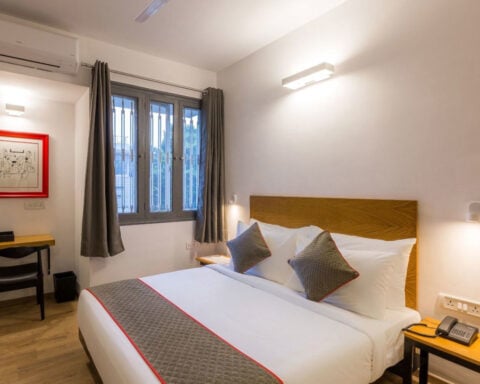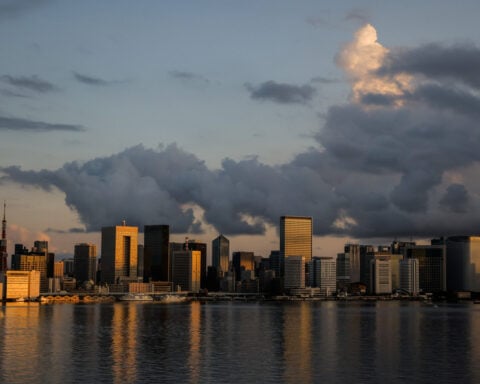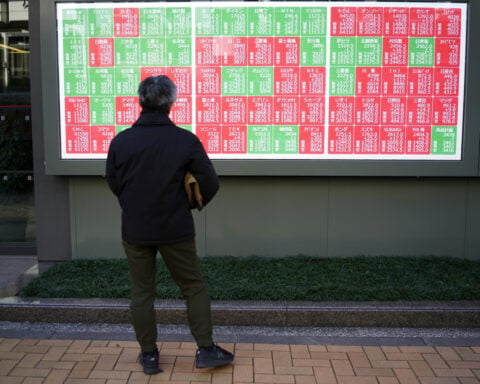(CNN) — Looking down a street in Daulatpur, a rural village in Punjab, India with a mishmash of eclectic, colorful architecture, photographer Rajesh Vora felt he had struck lucky. In front of him, was a large facsimile of an Air-India plane on top of a pale green building. Facing it from across the street, a replica of an army tank atop a yellow residence pointed its gun, the painted figure of a soldier rising from its hatch.
Though the designs could have been plucked from an amusement park, they were actually elaborate rooftop water tanks of private homes. Vora’s images of this phenomenon — a vernacular tradition of architectural icons that sprung up across the across the northwestern state some five decades ago — became a multiyear project that the Mumbai-based photographer is now exhibiting at Les Rencontres d’Arles in France this summer. He visited 150 villages and photographed hundreds of these designs.
The ostentatious décor is “a brilliant idea combining form and function,” Vora said in a phone call with CNN. The first time he noticed the water tanks while on assignment in the region in 2014, he was “amused, like anybody would be seeing this kind of sculpture,” he explained. “But then I realized, as an architecture photographer, what amazed me was the integration of the sculptures on the houses, built by local artisans.”
Crowning the tops of these homes, the unusual status symbols are often commissioned by Indian emigrants who return home during the year, or by their families who still live in the region. Some are functional water tanks while others sit on top more traditional plumbing designs. Each tell a specific story, he explained.
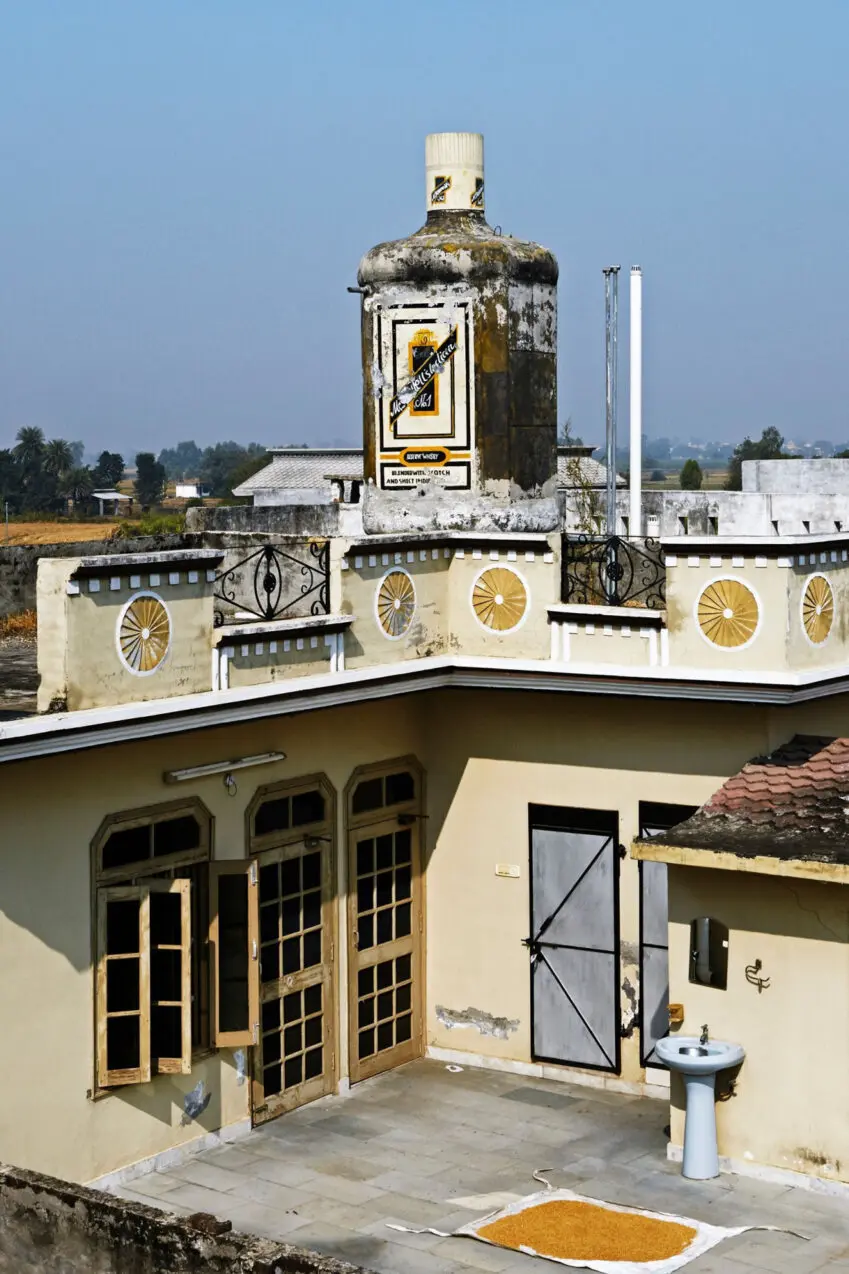
“If somebody plays sports, they’ll put up a football there, if they are a chef they will put a pressure cooker… if somebody likes a nice drink, they’ll put a bottle of whiskey,” he explained. Planes, tanks and cars became popular motifs, too. “All their personal aspirations are embodied in their houses.”
Last year, Vora published a book, “Everyday Monuments” that features images from some the villages he visited and brings together texts from architectural, scholarly and curatorial experts to explore the unique tradition. Through their research, they approximate that there are around 30 artisans in the region who work with homeowners and their families via word of mouth to create these lively sculptures.
Diasporic icons
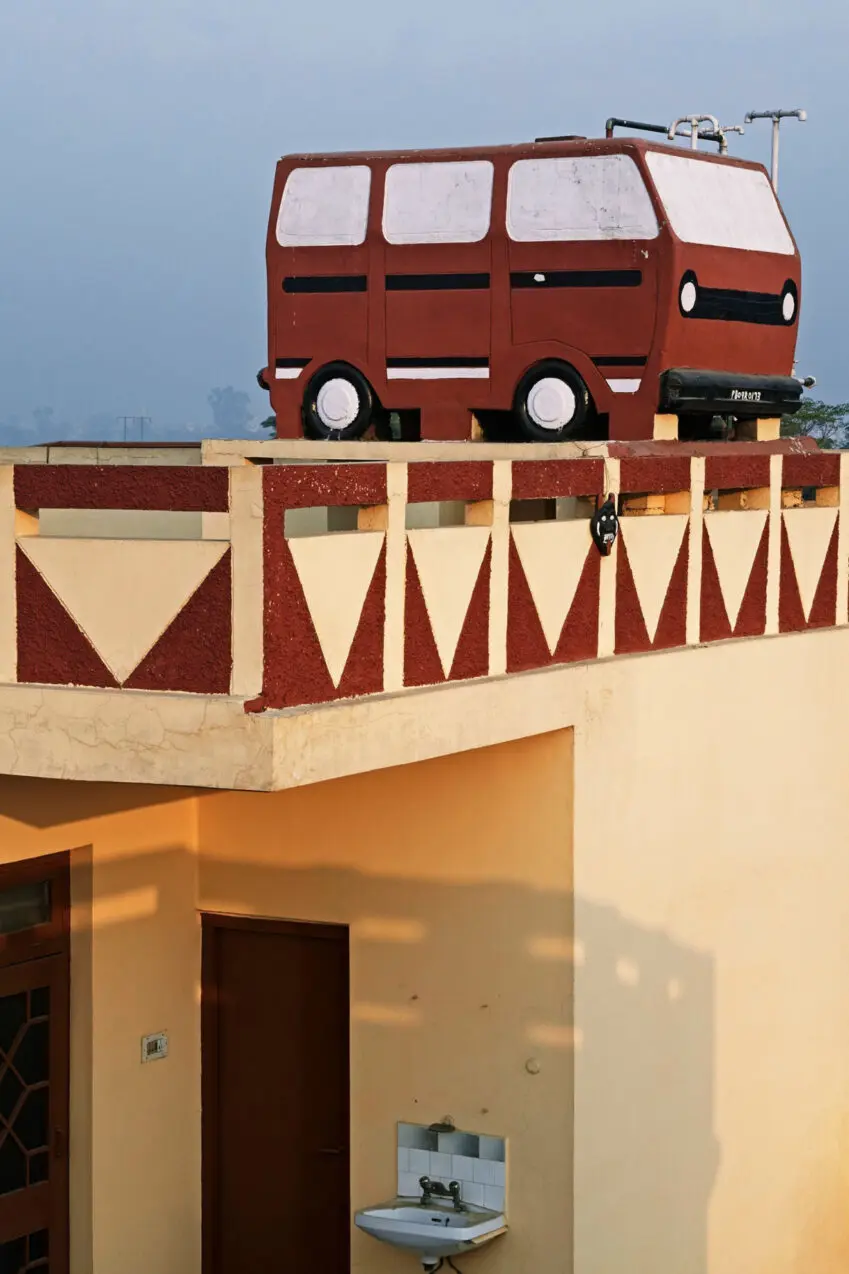
Vora came across the buildings by chance, as he visited a gurdwara — a Sikh temple — in the village of Talhan while working on a commissioned photo story about global migration. Known as Hawaijahaj, or “Airplane,” gurdwara, visitors bring offerings of model aircraft in hopes that they will be blessed with swift visa approval to leave India. He heard that many who were successful eventually returned to their villages to add planes to the exteriors of newly built homes, he explained.
Over the course of six trips from 2014 to 2019, Vora began to better understand the full scope of the trend. It had begun sometime in the 1970s, as Punjabi diasporic communities flourished in Canada, the United Kingdom and the United States, among other countries. As the popularity of custom-designed water tanks grew, local builders became specialized in their craft. The favored icons tend to shift in popularity over the years — when the country began manufacturing its popular Maruti van, for example, in the 1980s, it began appearing on homes, too. He also observed how architectural styles from different countries began to mix into the villages as owners brought back ideas from abroad to unique effect.
But documenting the water tanks proved difficult when he first began. The remote areas of Punjab weren’t yet mapped by Google, he explained, so he visited villages and hoped for the best.
“Some days are lucky — you might get three or four kinds of water tanks; others, you might not get anything,” Vora said. Daulatpur Village, where multiple designs could be seen in one frame, was a rarity.
Vora doesn’t know how the tradition will grow or change as the region continues to see major shifts — especially as Indians from marginalized backgrounds gain more economic mobility and second- or third- generation immigrants amass wealth overseas.
“Will they come back to India? Will they build their own houses? Will they take care of these houses?” We don’t know,” Vora said of younger generations. “These houses are perishable if you don’t maintain them after 30 or 40 years… maybe they will disappear.”
The photographer hopes to continue to create an archive of Punjab’s distinctive architectural legacy — and he’ll keep looking out for a home that bears the icon of what he would choose if he were commissioning a design. “It would have to be a camera,” he said with a laugh. After traveling more than 3,500 miles, he has yet to spot one.
The-CNN-Wire
™ & © 2024 Cable News Network, Inc., a Warner Bros. Discovery Company. All rights reserved.

 Michigan Gov. Gretchen Whitmer, a potential 2028 candidate, wants to find common ground with Trump
Michigan Gov. Gretchen Whitmer, a potential 2028 candidate, wants to find common ground with Trump
 Biden promised to turn the page on Trump. Now he's being replaced by him
Biden promised to turn the page on Trump. Now he's being replaced by him
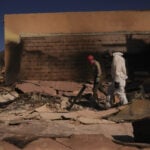 Firefighters prepare for increasing gusts following brief reprieve for LA area
Firefighters prepare for increasing gusts following brief reprieve for LA area
 Nippon Steel wants to work with Trump administration on US Steel deal, Mori tells WSJ
Nippon Steel wants to work with Trump administration on US Steel deal, Mori tells WSJ
 After cable damage, Taiwan to step up surveillance of flag of convenience ships
After cable damage, Taiwan to step up surveillance of flag of convenience ships
 BOJ will raise rates if economy, price conditions continue to improve, Ueda says
BOJ will raise rates if economy, price conditions continue to improve, Ueda says
 Manatees congregate in warm waters near power plants as US winter storms graze Florida
Manatees congregate in warm waters near power plants as US winter storms graze Florida
 AAPI adults prioritize immigration, but split on mass deportations: AP-NORC/AAPI Data poll
AAPI adults prioritize immigration, but split on mass deportations: AP-NORC/AAPI Data poll
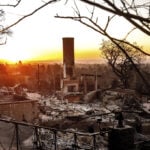 As Los Angeles burns, Hollywood's Oscar season turns into a pledge drive
As Los Angeles burns, Hollywood's Oscar season turns into a pledge drive
 As fires ravage Los Angeles, Tiger Woods isn't sure what will happen with Riviera tournament
As fires ravage Los Angeles, Tiger Woods isn't sure what will happen with Riviera tournament
 Antetokounmpo gets 50th career triple-double as Bucks win 130-115 to end Kings' 7-game win streak
Antetokounmpo gets 50th career triple-double as Bucks win 130-115 to end Kings' 7-game win streak

